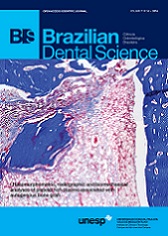Self-medication in patients with temporomandibular disorders
DOI:
https://doi.org/10.14295/bds.2014.v17i4.1051Resumo
Temporomandibular Disorders (TMD) are a set of painful and / or functional clinical problems that affect the joints and / or muscles of the orofacial region. The practice of self-medication, defined as the consumption of unprescribed drugs, is explained in most TMD patient cases by the occurrence of constant pain, producing discomfort and fatigue, while performing essential functions such as chewing, speaking, and swallowing, causing a drop in the quality of life of patients who have this disorder. Because of this, many see medication as a quick and sufficient means of addressing the problem of pain, and do not seek help from a professional. This study therefore aimed to evaluate, through guided interviews, the practice of self-medication in patients with temporomandibular disorder. The researchers interviewed 115 patients who were referred for treatment at the Diagnosis and Treatment Service for Patients with Temporomandibular Disorder (TMJ Service), School of Dentistry, Federal University of Juiz de Fora. In the sample studied there was a high prevalence of self-medication among the patients interviewed, of whom 71.3% used medication without a prescription, with a majority being female (84.14%). Headache was the main complaint reported by patients who self-medicated (39.53%), analgesics the most used drug class (58.13%), and most of the pain relief drugs were acquired through old prescriptions (40.25%). Thus, this work emphasizes the importance of guiding the patient and the professional regarding this practice.
Downloads
Downloads
Arquivos adicionais
Publicado
Como Citar
Edição
Seção
Licença
TRANSFERÊNCIA DE DIREITOS AUTORAIS E DECLARAÇÃO DE RESPONSABILIDADE
Toda a propriedade de direitos autorais do artigo "____________________________________________________________________" é transferido do autor(es) para a CIÊNCIA ODONTOLÓGICA BRASILEIRA, no caso do trabalho ser publicado. O artigo não foi publicado em outro lugar e não foi submetido simultaneamente para publicação em outra revista.
Vimos por meio deste, atestar que trabalho é original e não apresenta dados manipulados, fraude ou plágio. Fizemos contribuição científica significativa para o estudo e estamos cientes dos dados apresentados e de acordo com a versão final do artigo. Assumimos total responsabilidade pelos aspectos éticos do estudo.
Este texto deve ser impresso e assinado por todos os autores. A versão digitalizada deverá ser apresentada como arquivo suplementar durante o processo de submissão.




























